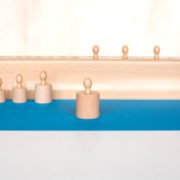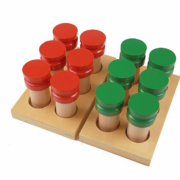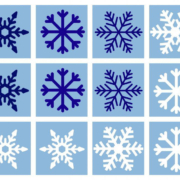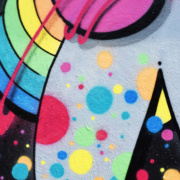Sensorial: Pink Tower
The Pink Tower is a sensorial material that teaches children sizing, dimension and order. It consists of 10 wooden cubes, ranging in size from 1 cubic centimetre to 10 cubic centimetres, differing in three dimensions. Lessons with the Pink Tower aim to refine a child’s visual sense by discriminating differences in dimension and interestingly, little ones are completely unaware of the deep significance of what they are learning; to them, they are simply playing with blocks.

Initially, children are introduced to the Pink Tower in its vertical form, standing proudly in their work space. The lesson proceeds by removing one block at a time from the tower, which are placed horizontally (in order) on a work mat, offering a visual representation of smallest to largest and vice versa. Children will be shown how to reconstruct the tower using the blocks, largest to smallest. No language is required as the lesson is demonstrated.
Blocks are placed and displaced by children one at a time, in intentional precise movements. As well as a lesson on dimension and sizing, the Pink Tower encourages body control and concentration – which are essential to the process of creating order.
Watch the below video of a little girl building a Pink Tower (applying the aforementioned principles); the blocks are in a mess and she manages to work out the order in which they go based ion their size:
Once children become confident in deconstructing and constructing the Pink Tower, follow up lessons that include the use of language may be introduced. Typically, this is done in the form of three-part lessons, which introduce concepts to children through a process of naming, association and recall. An example of this might be the concept of “big, bigger and biggest” where a Montessori directress would use three different sized blocks from the tower to introduce this new vocabulary by first naming it, and then applying it to the corresponding blocks so children can make an association between size and concept, and then asking children to recall the association. Importantly, one should not start the recall stage unless a child confidently grasps the association stage. If a child is struggling to grasp the concept, simply reiterate the association and if that’s not working, go back to the beginning (one of the initiating exercises) so that the child is left feeling confident!
There is no failure in these lessons; it’s a learning process and, as with most Montessori materials, the Pink Tower is designed to be self-correcting. If cubes are all out of order upon your child’s initial engagement with the blocks, let it be; they will figure it out eventually – working out the order themselves. If they’re struggling to grasp concepts in the follow-up lessons, patience and repetition will help the learning process.
And why are the blocks pink? Well, Maria Montessori experimented with a variety of colours but observed that the children were more attracted to the colour pink, compared to the other colours.
If you’d like further information about this tutorial, feel free to contact us at info@standrewsmontessori.com. We’re happy to answer any questions.















